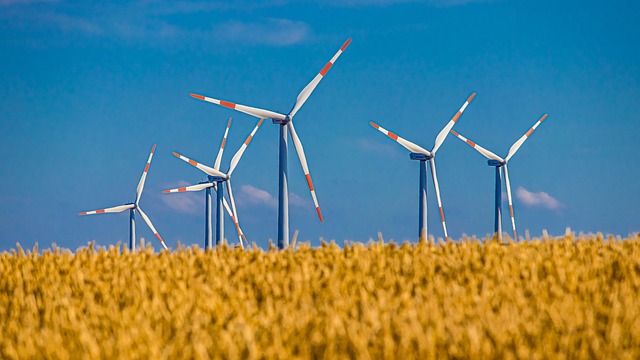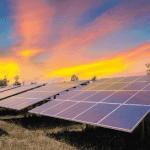
Why Do Not Some Wind Turbines Turn?
The wind is blowing, but in wind farms there is a lull in the wind in places – so the question arises: Why do some wind turbines not turn and others do? There is not only one answer to this question.
Wind turbines consist of curved rotor blades around which the wind flows. The principle of buoyancy comes into play here: The air must take a longer path on the bulbous upper side of the rotor blade and flow faster than on the hollow lower side. This results in a higher pressure on the underside than on the upper side, which leads to the buoyancy force. It moves the blade and causes the rotor to rotate. A generator converts the resulting rotational energy into electricity that can be fed into the power grid.
If you live near a wind farm or have ever driven past one attentively, you might have noticed: Not all wind turbines are always in motion – even though the wind is going. It can happen that the rotors temporarily stand still for several hours. But why do some wind turbines not turn and others do? This can have different reasons.
Table of Content
Wind Turbines And The Wind
So if a wind turbine is not moving, the most obvious assumption is that there must be no wind. In fact, according to Stadtwerke Münster, that’s usually the reason wind turbines don’t turn. The turbines need a wind speed of about three meters per second, and this must be continuous: Individual gusts cannot set the rotors in motion.
Even within small distances, wind conditions can vary greatly. For example, on the ground you may feel a distinct breeze blowing, but at the height of the rotors it may be windless.
By the way: Even if it is too windy, wind turbines can stand still. In a storm of force nine or higher, the turbines shut themselves down so as not to overstress the materials.
Other Reasons
For animal welfare reasons, wind turbines sometimes do not rotate. Apart from the wind, there are also other unavoidable reasons why wind turbines do not rotate:
- Animal protection: Particularly in the summer months, some wind turbines stand still in the morning and evening hours and at night so as not to disturb the flight of bats. Measures for bird protection also stipulate that the rotors stand still at certain times.
- Shadow cast: The shadow cast by turbines in the vicinity of built-up areas – for example residential buildings – must not exceed certain limits. The rotors may only cast shadows on surrounding buildings for a limited time per day. To prevent this time from being exceeded, the turbine switches itself off if necessary when it approaches the limit value. To do this, it continuously calculates where its shadow falls from its position and the current position of the sun.
- Maintenance: Regular maintenance or spontaneous repairs are due each year, for which the wind turbines must be out of service.
Limping Grid Expansion Cripples Wind Turbines
When grid bottlenecks occur, wind turbines are the first to be taken out of service.
So sometimes it’s unavoidable that wind turbines won’t turn: because of weather, sun position, nature and animal conservation, or maintenance work. But often the turbines could generate electricity, but are not allowed to, or it is simply not worth it for the operators:inside. The reasons are as follows:
Too much power: If there is excess capacity in the power grids, wind turbines also stand still because of so-called feed-in management. Sometimes there is so much energy available from different sources that not all of it can be fed into the grids. To avoid overloading, grid operators usually shut down wind turbines first. This is because they can be shut down and restarted more flexibly than other plants such as coal-fired power plants. Conventional power plants are also tied to the conventional minimum generation. They may only be shut down to the extent that they can still provide their balancing power. As reported by Tagesschau, according to the German Federal Network Agency, around 5.8 billion kilowatt hours of electricity from wind power were not fed into the grid in 2021. This amount could cover about one percent of Germany’s total electricity consumption.
Negative electricity prices: Negative electricity prices occur when the supply of electricity exceeds demand and prices fall, sometimes even below zero. According to the Tagesschau, operators often shut down their wind turbines because electricity production is not profitable. When prices are negative, they have to pay extra if they want to feed their wind energy into the power grid.
To remedy these problems, the power grid must be expanded. According to the Federal Network Agency, a total of 101 projects with a total length of around 12,300 kilometers are planned as of 2022. Of these, around 2,600 kilometers are still in the approval process, while around 7,100 kilometers are in the middle of it. And only about 1,900 kilometers have already been completed.
As long as the infrastructure is not adapted to the German government’s goal of covering at least 80 percent of gross electricity consumption from renewable energies by 2030, this goal can hardly be achieved – and wind turbines will stand still even more frequently.


